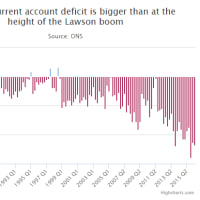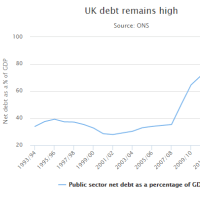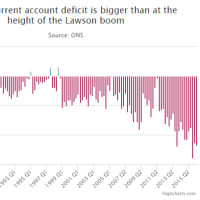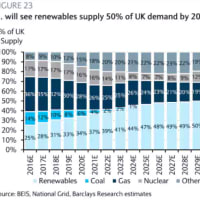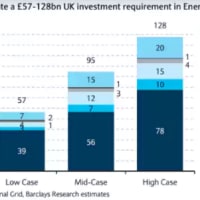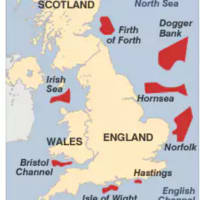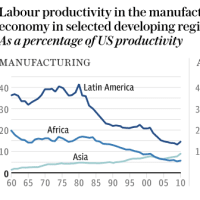Morgan Stanley warns on Asian debt shock as dollar soars
(米ドル急騰。モルガン・スタンレー、アジア債務ショックをワーニング)
By Ambrose Evans-Pritchard
Telegraph: 5:00AM BST 29 Sep 2014


(米ドル急騰。モルガン・スタンレー、アジア債務ショックをワーニング)
By Ambrose Evans-Pritchard
Telegraph: 5:00AM BST 29 Sep 2014
Foreign debt in emerging Asia has soared from $300bn to $2.5 trillion over the last decade
アジアの新興国の対外債務残高は過去10年間で3,000億ドルから2.5兆ドルまで爆増しました。
Debt ratios in developing Asia have surpassed extremes seen just before the East Asian financial crisis blew up in the late 1990s and companies have borrowed unprecedented sums in dollars, leaving the region highly vulnerable to US monetary tightening.
アジアの開発途上国の債務比率は、1990年代終盤にドカーンといった東アジア金融危機直前のヤバさを上回りました。
ついでに、これらの国の企業はドル建てで前代未聞の規模の借金を積み上げました。
おかげさまで、この地域は米国の金融引き締めに極めてやられ易い状態となってしまいました。
Morgan Stanley said foreign debt in emerging Asia has soared from $300bn to $2.5 trillion over the last decade, creating the risk of a currency shock as the dollar surges to a four-year high and threatens to smash through key technical resistance.
モルガン・スタンレー曰く、アジアの新興国の対外債務は過去10年間で3,000億ドルから2.5兆ドルまで爆増して、米ドルが4年ぶり最高値へ駆け上がって主要テクニカル抵抗線を粉砕しようとしている時に、通貨ショックのリスクを生み出している、とのこと。
"High dollar liabilities do not bode well for emerging markets. In Asia (excluding Japan), the credit-to-GDP gap has reached levels higher than 1997," it said.
「米ドル建て借金山積みって新興市場にはヤバいよね。アジア(日本は別だけど)の信用残高の対GDP比は1997年を超えちゃった」そうです。
The US bank warned clients that local lenders in Asia have relied increasingly on the wholesale capital markets - a little like Northern Rock before 2007 - allowing them to expand credit faster than deposit growth. This leaves them exposed if liquidity dries up.
また、アジアの現地金融機関のホールセール市場依存症は悪化の一途(2007年までのノーザンロックっぽい)、おかげで預金が増えるのを待たずに貸し出しを増やせている、とクライアントにワーニングを出しました。
流動性が枯渇したらイチコロなのです。
Asia's credit-to-GDP gap measures how far loan expansion has pulled ahead of the underlying trend growth of the economy. It peaked at 10pc in 1997. This time a flood of cheap money from Western central banks and the Chinese authorities has pushed it to 15pc, clear evidence of credit exhaustion as productivity stalls and the region's economic model looses steam.
アジアの信用残高の対GDP比って、融資拡大が基本的な経済成長トレンドのどれだけ先を行っちゃってるかを測るものです。
1997年10%がピークでした。
今回、西側の中銀やら中国政府からあふれ出した低金利資金のおかげで15%に達しちゃいました。
生産性が横這いになってアジア新興市場の経済モデルが息切れして信用の力も尽きちゃったという明らかな証拠であります。
The bank's currency team said the region could be hit on two fronts at once: a credit squeeze as rising US rates push up borrowing costs across the world, combined with an exchange rate squeeze on "short" dollar positions. The response to one complicates the other.
同行のカレンシー・チームに言わせると、この地域は一度に二方向からやられるかもね、とのこと。
つまり、米国金利上昇による世界中の借入コスト上昇が招く信用不足と、米ドル「ショート」ポジションへのドル高のコンボ。
Morgan Stanley's technical analysts say the dollar is poised to break its thirty-year downtrend as the Fed turns hawkish. It expects the dollar index - a broad gauge of the dollar exchange rate -- to surge towards 92 by next year if it breaks through resistance at 87. Such a move would be comparable to the global dollar shock that caused such strains twenty years ago.
モルガン・スタンレーのテクニカル・アナリストは、FRBがタカ化してるから米ドルは30年間のダウントレンドをぶっ壊しそうと言ってます。
米ドル指数(米ドル為替レートのざっくりゲージ)が抵抗線の87を突き抜けたら、来年までに92へと急上昇するんじゃないかとの予測です。
そんなことになったら20年前の世界的な米ドル不足ショック再びってことになるんじゃ…。
The Asian Development Bank (ADB) warned last week that the area should brace for "tighter liquidity" and possible "capital outflows" as the US ends quantitative easing in October. "While the region's bond markets have been calm in 2014, the risks are rising, including earlier than expected interest rate hikes by the Federal Reserve," it said.
アジア開発銀行は先週、このエリアは米国が10月にQEを止めた時の「流動性の減少」に備えて「資本流出」の可能性も覚悟すべきだと警鐘を鳴らしました。
「ここの債券市場は2014年も落ち着いていたけどリスクは高まってるから。FRBが予想よりも早い利上げする可能性とかね」とのこと。
The Fed was buying $85bn of bonds each month as recently as January. A fall to zero amounts to a major shift in global financial dynamics even before rates rise.
FRBはつい1月まで毎月850億ドルもの債券を買っていました。
これがゼロになるっていうのは、利上げの前でも、国際金融のダイナミクスの大シフトでしょ。
The ADB said in its Bond Monitor that emerging Asia issued a record $1.1 trillion of local currency bonds in the second quarter of 2014, pushing the total stock to $7.9 trillion. Most debt is at maturities below three years, creating roll-over risk. This does not include $1.5 trillion of cross-border bank loans and over $1.2 trillion in foreign currency bonds on latest estimates, mostly in dollars and owed by companies.
更にADBはボンド・モニターに、アジアの新興国が2014年第2四半期に発行した現地通貨建て債券は史上最高の1.1兆ドル、合計残高は7.9兆ドルまで増えた、と書いています。
殆どは償還期限3年以内だからロールオーバー・リスクが…。
しかもこれには国際融資(1.5兆ドル)とか、殆ど米ドル建てだったり社債だったりする外貨建て債券(直近試算で1.2兆ドル+)は入ってませんから。
Local bond issuance over the last year has jumped by 36pc in Vietnam, and 32pc in Hong Kong. China accounts for the lion's share of outstanding bonds. China Railway alone accounts for $975bn in yuan debt, and China State Grid a further $415bn.
この1年間の債券発行額はベトナムが+36%に香港+32%です。
まあ、一番は中国ですけど。
人民元建ての債券残高は中国鉄道だけで人民元建てで9,750億ドル、チャイナ・ステート・グリッドが4,150億ドルです。
The Bank for International Settlements devoted its latest quarterly report to mounting leverage and dollar debt in emerging markets, especially in Asia. It said cross-border loans to China had jumped by 49pc to $1 trillion in the year to March 2014.
BISは最新の四半期レポートを、新興市場、特にアジアの新興市場でむくむく増えるレバレッジと米ドル建て債務スペシャルにしましたね。
対中国際融資の額は2014年3月までの1年間で49%も急増して1兆ドルになったとか。
The BIS said ultra-easy money had led to a "ubiquitous quest for yield", driving "huge investment flows" into emerging markets. "In many jurisdictions, corporates have opted to lock in low global interest rates and to sharply increase their international debt issuance. This could be a source of powerful feedback loops in response to exchange rate and/or interest rate shocks," it said.
それから、超低金利資金は「普遍的な金利探究」をもたらして、新興市場に「巨額の投資資金を流入」させるとも言ってます。
「多くの管轄権において、企業は世界的低金利に確定することを選択し、更にその国際債務を急増させることを選択した。これは為替レートおよび/または金利ショックに応じる強力なフィードバック・ループの元になり得る」んだそうです。
"It all looks rather familiar. The dance continues until the music eventually stops. Markets will not be liquid when that liquidity is needed most. And yet the illusion of permanent liquidity is just as prevalent now as in the past," said Claudio Borio, the BIS's chief economist.
「全てがかなり見慣れた光景である。音楽が最終的に止まるまでダンスは続く。流動性が最も必要とされている時に、マーケットは流動的ではないだろう。それでも、恒久的流動性の幻想は過去と同じ位今でも一般的である」とBISのチーフ・エコノミスト、クローディオ・ボリオ氏は言いました。
In stark contrast to the late 1990s, Asian states have borrowed in their own currencies and have little foreign debt. Most have large reserves. However, the BIS fears the region may be vulnerable through different channels, this time via private dollar debt and extreme sensitivity to rising rates on local debt.
1990年代終盤とガラッと違うのは、アジアの国が自国通貨建てで借金してて、外貨建ては殆どないってことですね。
殆どの国には準備が山積みされてるし。
でも、BISは別のルート、今回は例えば民間の米ドル建て借金とか、自国通貨建て債務が金利上昇に超センシティブとかいうルートでヤバくなるかもと思ってるわけです。
Emerging markets have had time to adjust since the first "taper tantrum" in May-June last year when hints of Fed tightening triggered a sudden-stop in capital flows. Yet most continued to build up debt briskly afterwards, borrowing at record low rates averaging 1pc in real terms. The BIS is concerned that these rates could snap back suddenly.
新興市場はFRBの引き締めヒントで資本の流入に急ブレーキがかかった去年の5-6月の第1次「テーパーかんしゃく」の後、時間があったじゃん。
なのに殆どの連中は直ぐにまた、実質ベースで平均1%とかいう史上最低の金利で借りまくって借金を積み上げ続けたわけですわ。
The Fed signalled at its latest meeting that its benchmark rate will rise more steeply next year than markets had expected, setting off jitters worldwide. The great question is whether "rates rage" will prove as fleeting as the taper tantrum.
FRBは直近の会議で、ベンチマーク金利は来年になったらマーケットが思ってるよりガーンと上がって世界中あたふたすることになるかもよ、とほのめかしました。
大きな問題は、「レーツレージ」がテーパーかんしゃくほど短命かどうかってことであります。











